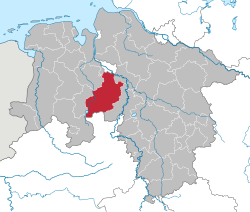Landkreis Diepholz
| Diepholz | ||
|---|---|---|
| District | ||
|
||
 |
||
| Country |
|
|
| State | Lower Saxony | |
| Capital | Diepholz | |
| Area | ||
| • Total | 1,987 km2 (767 sq mi) | |
| Population (31 December 2015) | ||
| • Total | 213,976 | |
| • Density | 110/km2 (280/sq mi) | |
| Time zone | CET (UTC+1) | |
| • Summer (DST) | CEST (UTC+2) | |
| Vehicle registration | DH | |
| Website | diepholz.de | |
Diepholz (German pronunciation: [ˈdiːphɔlts]) is a district in Lower Saxony, Germany. It is bounded by (from the northeast and clockwise) the districts of Verden, Nienburg, Minden-Lübbecke (in North Rhine-Westphalia), Osnabrück, Vechta and Oldenburg, and by the cities of Delmenhorst and Bremen. The biggest city is Stuhr.
From the 12th century to 1585 Diepholz was a sovereign Noble Lordship, later County, within the Holy Roman Empire that was ruled over by the Noble Lords, later Counts, of Diepholz. At the beginning of the 16th century there was great pressure from the powerful duchy of Brunswick-Lüneburg, which tried to annex the smaller states. By forming an alliance with the neighbouring County of Hoya and asking for help from the emperor himself the state of Diepholz managed to survive some more decades. In 1585 the ruling family became extinct, and Diepholz was eventually annexed by Brunswick-Lüneburg.
In 1932, the district of Grafschaft Diepholz (County of Diepholz) was established by merging the former districts of Diepholz and Sulingen. The former district of Diepholz was roughly identical to the medieval state, while the Sulingen district had been a part of the County of Hoya.
...
Wikipedia

